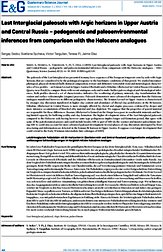| dc.contributor.author | Sedov, Sergey | |
| dc.contributor.author | Sycheva, Svetlana | |
| dc.contributor.author | Pi, Teresa | |
| dc.contributor.author | Díaz, Jaime | |
| dc.date.accessioned | 2013-06-17T19:51:10Z | |
| dc.date.available | 2013-06-17T19:51:10Z | |
| dc.date.issued | 2013-06-17 | |
| dc.identifier.citation | E&G – Quaternary Science Journal; Vol.62, No.1, p.44-58 | |
| dc.identifier.uri | http://hdl.handle.net/11858/00-1735-0000-001F-31B2-0 | |
| dc.description.abstract | The paleosols of the Last Interglacial are presented in many loess sequences of the European temperate zone by soils with Argic horizon, that are considered to be the pedological response to the bioclimatic conditions of that period. We studied micromorphological, physical/chemical (bulk chemical composition, texture and dithionite-extractable iron) and mineralogical characteristics of two profiles – an Eemian Luvisol in Upper Austria (Oberlaab) and a Mikulino Albeluvisol in Central Russia (Alexandrov Quarry near Kursk) to compare them with recent analogous soils and to make further paleoecological and chronological inferences. Both profiles showed a set of characteristics indicative for weathering of primary minerals, clay transformation illuviation and surface redoximorphic (stagnic) processes. Paleosols demonstrate more advanced development than the Holocene analogues manifested however in different pedogenetic characteristics. The Eemian Luvisol in Upper Austria is characterized by stronger clay illuviation manifested in higher clay content and abundance of illuvial clay pedofeatures in the Bt horizon. Mikulino Albeluvisol in Central Russia is more strongly affected by eluvial and stagnic processes evidenced by deeper and more intensive accumulation of bleached silty material and clay depletion. We suppose that the properties of parent material are responsible for these differences. Russian Albeluvisol is formed on the Dnepr loess poor in weatherable minerals and having limited capacity for buffering acidity and clay formation. The higher development status of the Last Interglacial paleosols compared to the Holocene soils having however same type pedogenesis implies longer soil formation period, that agree with some of the paleobotanical proxies and could include besides MIS 5e part of MIS 5d; the warmer and moister paleoclimate during MIS 5e could also account for more advanced paleosol development Several phases of clay illuviation interrupted by frost structuring and deformation are detected in the Eemian Bt horizon in Upper Austria. It suppose even longer development that could extend to the Early Würmian interstadials (late substages of MIS5). | |
| dc.language.iso | eng | |
| dc.publisher | Geozon Science Media | |
| dc.relation.ispartofseries | E&G | |
| dc.subject.ddc | 551 | |
| dc.title | Last Interglacial paleosols with Argic horizons in Upper Austria and Central Russia | |
| dc.type | article | |
| dc.bibliographicCitation.volume | 62 | |
| dc.bibliographicCitation.issue | 1 | |
| dc.bibliographicCitation.firstPage | 44 | |
| dc.bibliographicCitation.lastPage | 58 | |
| dc.identifier.doi | 10.23689/fidgeo-1937 | |
| dc.type.version | Verlagsversion | |
| dc.rights.holder | Geozon Science Media | |
| dc.date.updated | 2013-06-17T19:51:11Z | |
| dc.subject.free | paleosol | |
| dc.subject.free | paleoclimate | |
| dc.subject.free | last interglacial | |
| dc.subject.free | Argic horizon | |
| dc.relation.volume | E&G – Quaternary Science Journal; Vol.62 | |
| dc.bibliographicCitation.journal | E&G | |
| dc.relation.collection | Geologische Wissenschaften | |
| dc.description.type | research | |


